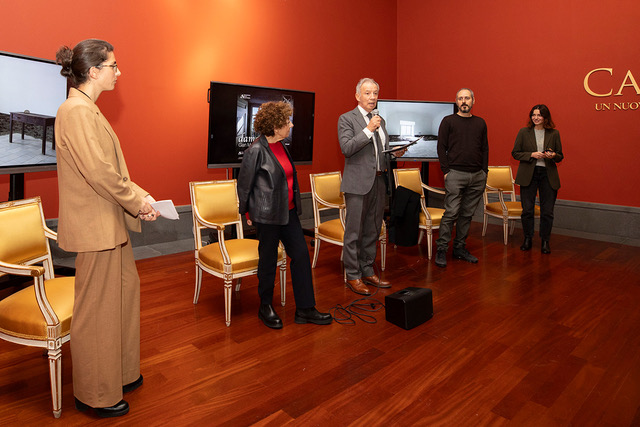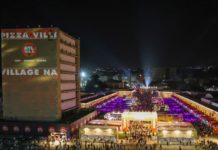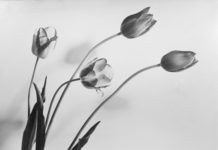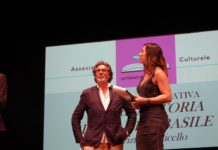Damasa. Così s’intitola l’opera di Gian Maria Tosatti presentata stamattina nella sala Caravaggio al secondo piano del Museo e Real Bosco di Capodimonte (foto).
L’installazione, allestita in permanenza nella sala 82 della Reggia, è acquisita in collezione grazie al sostegno del PAC 2022-2023 – Piano per l’Arte Contemporanea, promosso dalla direzione generale creatività contemporanea del ministero della cultura.
Alla presentazione hanno partecipato con Tosatti, il direttore Sylvain Bellenger, curatore del progetto, Angela Tecce, presidente della Fondazione Donnaregina per le Arti Contemporanee – Museo Madre di Napoli, Francesca Gallo per la Galleria Lia Rumma, Luciana Berti, assistente di direzione del Museo.
In occasione della presentazione di Damasa, opera dedicata ad Anna Maria Ortese, sono esposte all’ingresso della sala le sculture Levriera che allatta i cagnolini (1839) e Gesù Nazareno (ante 1857), legate alla produzione dello scultore Giuseppe Vaccà, nonno materno dalla scrittrice napoletana, spesso evocato nelle sue pagine.
Realizzata ed esposta a Napoli per la prima volta nel 2017, Damasa è l’installazione ambientale ideata come casa dell’anima di Anna Maria Ortese, la principale autrice che la città ha avuto nel suo Novecento letterario. Il titolo dell’opera deriva dal nome che la scrittrice diede a uno dei personaggi del romanzo sperimentale Il porto di Toledo, nel quale riconosciamo il suo alter-ego.
Accogliendo la volontà dell’artista di non esporre l’opera lontano da Napoli, Sylvain Bellenger, nel doppio ruolo di Direttore del Museo di Capodimonte e di curatore del progetto, ha destinato la sala 82, al secondo piano della Reggia, all’esposizione permanente dell’installazione, restituendo uno spazio reale e al contempo visionario alla scrittrice e infrangendo l’esilio che l’ha lungamente relegata a centinaia di chilometri di distanza dalla sua città.
L’installazione ambientale di Tosatti riproduce uno spazio domestico. In una camera unica, circondata da cumuli di cenere e di giornali bruciati, su un vecchio pavimento, trovano spazio alcuni mobili, un letto, un tavolo e una sedia.
Il legno, le lenzuola o un pezzo di pane mutano la loro sostanza in onice bianco, una materia che, nella poetica di Tosatti, è spesso usata come analogia dell’anima. Come in altre opere dell’artista la presenza degli esseri che vivono un luogo determina una osmosi, tra ambiente e umanità. Anche qui, la materia si contamina con lo spirito di chi abita lo spazio.
Damasa, è un’opera complessa. Intreccia lancinanti elementi biografici dell’artista e della scrittrice cui è dedicata. Riproduce uno spazio dell’anima e una stanza trasfigurata simile alle tante in cui ha vissuto tra Roma, Milano, Genova e Rapallo, dopo aver lasciato Napoli. Una storia senza tempo che interagisce con il pubblico: ciascuno può intravedere qui una parte di sé.
In occasione della presentazione di Damasa, sono esposte all’ingresso della sala 82 due sculture intitolate Levriera che allatta i cagnolini e Gesù Nazareno, legate alla produzione di Giuseppe Vaccà (Carrara 1803 – Napoli 1871), nonno materno di Ortese.
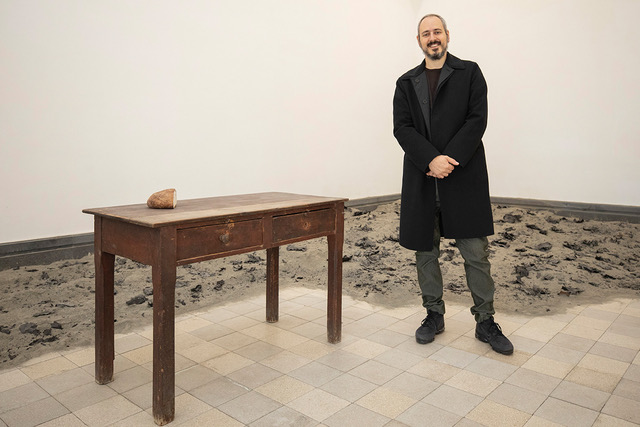
Capodimonte/ Damasa, an installation by Tosatti dedicated to writer Anna Maria Ortese. When a room becomes a place of the soul
Damasa. This is the title of the work by Gian Maria Tosatti presented this morning in the Caravaggio Room on the second floor of the Museum and Royal Forest of Capodimonte.
The installation, permanently installed in room 82 of the Reggia, has been added to the collection thanks to the support of the PAC 2022-2023 – Plan for Contemporary Art, promoted by the General Directorate for Contemporary Creativity of the Ministry of Culture.
Tosatti was joined at the presentation by director Sylvain Bellenger, curator of the project, Angela Tecce, president of the Fondazione Donnaregina per le Arti Contemporanee – Museo Madre in Naples, Francesca Gallo for Galleria Lia Rumma, and Luciana Berti, assistant director of the museum.
On the occasion of the presentation of Damasa, a work dedicated to Anna Maria Ortese, the sculptures Greyhound Suckling Little Dogs (1839) and Jesus Nazarene (before 1857), related to the production of the sculptor Giuseppe Vaccà, maternal grandfather of the Neapolitan writer often evoked in her pages, will be displayed at the entrance of the hall.
Created and exhibited for the first time in Naples in 2017, Damasa is the environmental installation conceived as the home of the soul of Anna Maria Ortese, the leading writer of the city’s literary twentieth century. The title of the work comes from the name given by the writer to one of the characters in the experimental novel The Port of Toledo, in which we recognize her alter ego.
Accepting the artist’s wish that the work not be exhibited far from Naples, Sylvain Bellenger, in the dual role of director of the Capodimonte Museum and curator of the project, has allocated Room 82 on the second floor of the Reggia for the permanent exhibition of the installation, returning to the writer a real and at the same time visionary space and breaking the exile that has long kept her hundreds of kilometers away from her city.
Tosatti’s environmental installation reproduces a domestic space. In a single room, surrounded by piles of ashes and burnt newspapers on an old floor, a few pieces of furniture, a bed, a table and a chair find their place.
Wood, sheets and a piece of bread mutate into white onyx, a material often used in Tosatti’s poetics as an analogy for the soul. As in other works by the artist, the presence of the beings that inhabit a place determines an osmosis between the environment and humanity. Here, too, matter is contaminated by the spirit of those who inhabit the space.
Damasa is a complex work. It weaves together painful biographical elements of the artist and the writer to whom it is dedicated. It reproduces a space of the soul and a transfigured space, similar to the many in which she lived between Rome, Milan, Genoa and Rapallo, after leaving Naples. A timeless story that interacts with the public: people can see a part of themselves here.
On the occasion of Damasa’s presentation, two sculptures entitled Greyhound Suckling Little Dogs and Jesus Nazarene, related to the work of Giuseppe Vaccà (Carrara 1803 – Naples 1871), Ortese’s maternal grandfather, are on display at the entrance to room 82.


